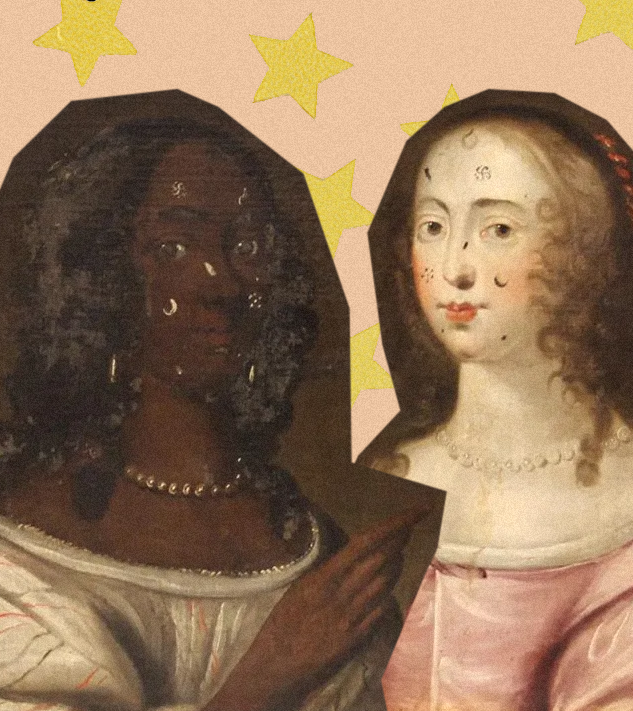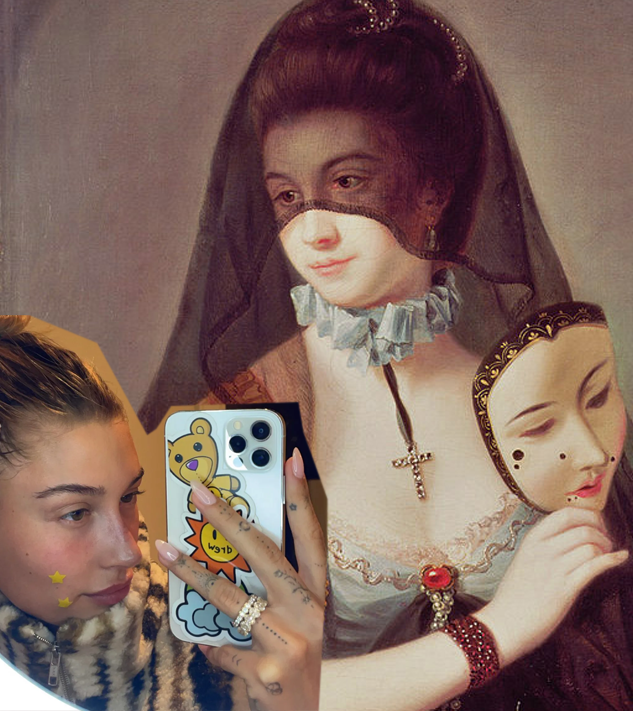Starry Eyed: The Rebellious History of Beauty Patches
Make it stand out
During one of my endless scrolls of art accounts online, I came across a painting that made me pause my thumb from virtually rummaging for images. I was stopped in my digital tracks while looking at an image featuring accessories that seemed, to me, too contemporary and frivolous for the era it was created in.
Painted by an unknown artist around 1650, Allegorical Painting of Two Ladies features two women are sitting next to each other at an angle, dressed in gowns where the neckline sits delicately at the edge of their shoulders with voluminous sleeves, nearly identical diamond necklaces encircle their necks, but the most eye-catching accessories depicted in this painting decorate each of their faces. Crescent moons, dots, and miniature constellations are placed in identical spots on each of the sitters’ faces. Faintly inscribed behind one lady is a text that criticises the use of cosmetics, but particularly beauty patches that were en vogue during this time period - it seems rebellion against beauty standards is timeless.
Formed out of black silk or velvet, beauty patches of the 17th and 18th centuries were adhered to the face with mastic (a resin-based adhesive) or saliva. The French referred to these beauty patches as mouches or “flies” because they resemble the appearance of an insect resting on the skin. In England, they were called plaisters or patches, but in all instances throughout Europe, they would be applied to the skin as a flirtatious way to conceal blemishes or marks from diseases like syphilis and smallpox. Sometimes they were even saturated with oils and placed at the temples to alleviate headaches. Despite the popularity of beauty patches, there were strict social codes marking the way one should decorate their face. Placement in specific areas of the face indicated political affiliations, marital status, and the quantity used was an initiate of taste (too many was gauche and too few was passé).
___STEADY_PAYWALL___
Beauty patches even made their way across the Atlantic in the 18th century, when Spanish colonisers landed in Latin America and were known as chiqueadores or peccas . One of the most famous examples of the chiqueador in art history is illustrated on the face of Doña María de la Luz in Miguel Cabrera’s portrait from around 1760. When the Spanish women came to the Americas they brought with them their taste for French fashions, which is evidenced by Doña’s elaborately patterned silk-brocade mantua and the five chiqueadores accessorising her face.
There are also depictions of women in the process of applying their patches. In an etching titled Morning by Gilles Edame Petit, a woman sits at her vanity with a feathered friend perched on the back of her chair, as she holds her open compact and curates the placement of her patches for the day. A circular shape balances on the tip of her finger as she looks at the viewer with curious expression, trying to decide where her third patch should go. Anne de La Grange-Trianon, a noted French aristocrat, also has a portrait of herself mid-beauty patch application while dressed in a corset with rosy pink ribbons tied across the front, completely in style for contemporary times in every way. Both of these artworks, I would say, are the proto-get-ready-with-me content we are familiar with today.
Fast forward a few centuries and we see that whimsical facial stickers have returned to make fashion statements. The facial patches of yesteryear were designed to make their wearer stand out in a crowd; they continue to elevate the outfits of the sartorially bold today. Unlike the facial patches of the 17th and 18th centuries, contemporary facial patches function in a practical manner saturated with ingredients to heal the blemishes they are designed to conceal. Brands like Starface, Blume, The Crème Shop, and Truly have continued the lineage of facial accessorisation by offering beautify patches in shapes like stars, hearts, flowers, and clouds, not dissimilar to the shapes depicted in Allegorical Painting of Two Ladies.
By adding contemporary beauty patches into their wardrobes, wearers are able to accentuate their faces with symbols that reveal their personality while concealing and treating a blemish. I had the opportunity to ask a few folks how these patches have enhanced their personal style and ended up receiving more insight into how they bolstered the wearers’ confidence. Pazia Luz, an artist and jewellery designer, enjoys playing with the various styles offered and appreciates how they aid in her sartorial expression, “Before Starface and similar products came out, pimple patches were only meant to conceal blemishes and basically be ‘invisible’ on the skin so it looks like you're not wearing a patch at all. Starface patches don't just cover what we regularly deem to be ‘embarrassing’ and ‘ugly,’ but they actually shine a light on those blemishes and provide a way for you to stand apart and to express yourself even more.”
“Fast forward a few centuries and we see that whimsical facial stickers have returned to make fashion statements. The facial patches of yesteryear were designed to make their wearer stand out in a crowd; they continue to elevate the outfits of the sartorially bold today.”
Clara Perlmutter, @tinyjewishgirl, a beauty and fashion content creator, appreciates that the actual function of minimising a blemish is reduced to a graphic that is festive, instead of revealing the graphic nature of their purpose. She also states that the limited edition Starface Hello Kitty collaboration is so cute, it just might be worth having a breakout just to have a reason to dress up her face with that of the beloved Sanrio character.
The aesthetics and purpose for beauty patches have remained consistent throughout the centuries, yet they have evolved into brand signifiers as opposed to remaining anonymous symbols that the wearer imbues with meaning. Through collaborations with globally recognised brands, like Glossier, patch producers are able to reel in a larger audience by relying on the popularity of well-known companies to ingratiate themselves into built in brand loyalty, however as consumers of these products, it’s worth considering how we become the mediators of unpaid marketing for these well funded and extremely popular brands. The Hello Kitty brand is worth over 80 billion dollars and by wearing her kitten face on our own, we provide viral marketing for free.
Profits are the goal for the companies behind the spot stickers and patch collaborations, not uplifting customers to feel better about their blemishes. Intertwining one’s identity with a brand is tricky business. It's difficult to resist buying into a trend that coincides with our inherent style decisions, but at what point does our taste get devoured by a big business? Do beauty patches still allow us the freedom to decorate our facial canvases to be supremely unique creations?
Words: Lauren Vaccaro


